The development of sound, color, and the widescreen process changed the way war looked on screen, increasing the ability for Hollywood filmmakers to work on a wider canvas with greater realism. The addition of the sounds of gunfire, the spectacle of red blood flowing, and complex spatial continuity increased the power of the war film to surprise and emotionally engage audiences. Changing morals loosened censorship restrictions, so using these new developments to increase gore, horror, and depictions of death and dismemberment was acceptable.
The presentation of war films was also influenced by moving pictures in newsreels and television. This history of “reality” as an influence can be traced back to the late 1890s. According to film historian Raymond Fielding, both the Spanish-American and the Boer Wars were covered on film. One of the first military conflicts to be captured on film, the Anglo-Boer War in South Africa attracted cinematographers from many countries after it broke out in 1899. Fielding also notes that the footage of the Spanish-American War of 1898 was a mixture of authentic and staged footage. Newsreels transmitted photographic news long before newspapers and magazines. The Mexican Revolution of 1914, for example, was well covered by moving picture cameras, and Pancho Villa (1878-1923), a revolutionary leader, signed an exclusive contract with Mutual Films. However, early news coverage was partly tainted by “reenactments” of major events that were sold as real. One such early recreation is the 1897 “miniaturized” Battle of Manila Bay (1898) by J. Stuart Blackton and Albert E. Smith. Other well-known reenactments include the assassination of President William McKinley (1843-1901), the sinking of the battleship Maine, the coronation of Edward VII, and the trial of Alfred Dreyfus.
Due to censorship rules and the reluctance of military personnel to allow civilian cameramen on the front lines, the U.S. Signal Corps was the main source of newsreel photography of World War I. Long-focus lenses were used, and the technical innovation of hand-held cameras, which did not require heavy tripods, made shooting easier. During the Second World War, coverage increased dramatically, although newsreels of the war were sent to Washington to be reviewed before being shown in theaters, mainly because of the military’s sensitivity to casualties or dead bodies by civilian audiences.
World War II made it possible to process footage quickly. This meant that the Second World War was the first war in which non-combatants could see events immediately after they occurred. Weekly newsreels, which presented parts of the extensive footage shot during the battle, were part of the regular program of every cinema during the war. There were also full-length documentaries produced by the liaison film units. The United States spends more than $50 million annually to obtain films about World War II. By the time the Vietnam War began, the development of lightweight television cameras and video recorders allowed television reporters to report nightly on Americans’ home screens.
Technology, whether in early newsreels, documentaries, or television, affects the artistic presentation of war films in three ways: viewers form expectations about the physical appearance of combat and war stories; filmmakers, having the same viewing experience, try to recreate the look and feel or even incorporate some of the footage into their stories; and when filmmakers who have shot real footage in the field return to civilian life, they often bring their experiences to feature films.
Today, the main technological developments affecting war films are digital. Computer-generated images allow filmmakers to create detailed and elaborate depictions of combat at a relatively low cost, as well as provide a new perspective on events. For example, Pearl Harbor showed the bombing of the USS Arizona from both a top view (dropping a bomb right under the hit) and a bottom view (diving underwater to see the struggle of the drowning men). As these processes continue to evolve and new technologies are invented, the appearance of war films will change accordingly, whether in terms of realism or stylized images of bullets flying.



